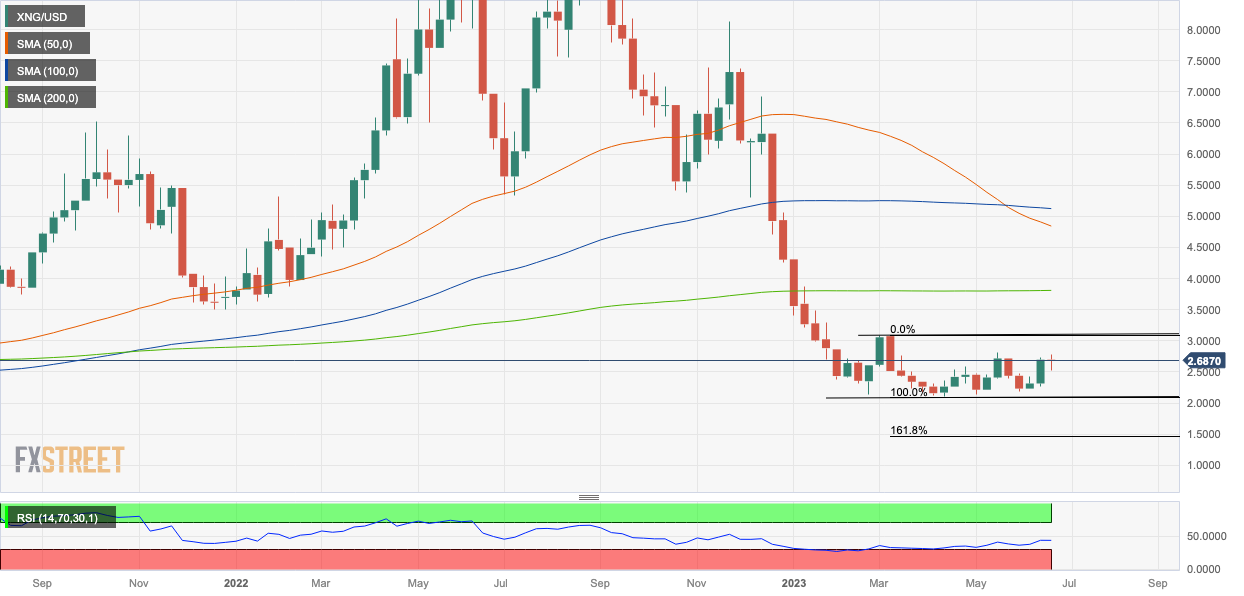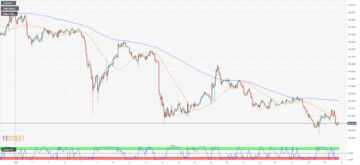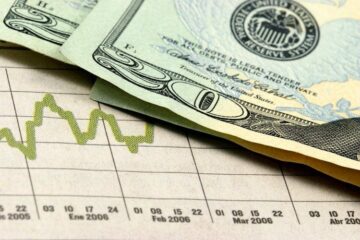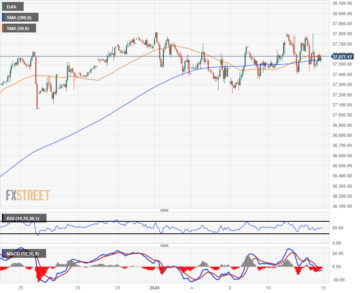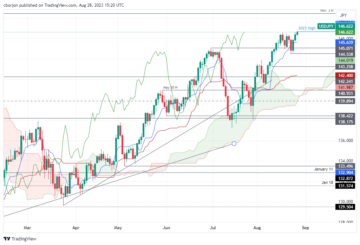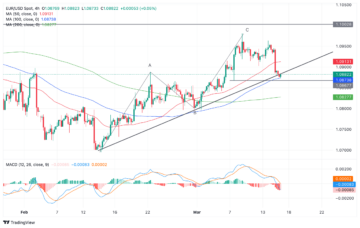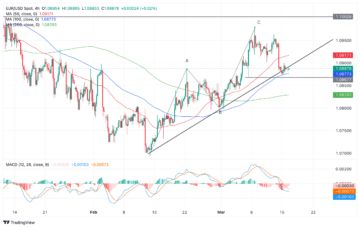- Natural Gas is down on Friday after lower-than-expected PMI data from around the world warns of a slowdown in demand.
- Prices had been climbing higher as hotter weather stoked demand for Gas to power air conditioning.
- Gas terminal closures and outages in Norway, Europe’s primary producer, further supported prices.
Natural Gas price is trading marginally lower heading into the weekend as macroeconomic data from major economies – especially the US – comes out overall lower than expected, raising concerns about growth and continued demand. PMIs in both Europe and the United States were overall lacklustre, raising fears about the outlook for the economy and demand for commodities.
XNG/USD is trading at $2.660 MMBtu, at the time of writing, entering the US session on Friday.
Natural Gas news and market movers
- S&P Global PMI data for the US showed a lower-than-expected result for Composite PMI which came out at 53.0 when 54.4 had been forecast. Manufacturing PMI showed a contraction. to 46.3 when 48.6 had been forecast, though Services, at 54.1, marginally beat estimates of 54.0. The data suggests the possibility that demand may shrink from a slowdown in growth.
- This followed on from lower-than-forecast PMIs in Europe and the UK.
- Natural Gas price had been rising over recent days due to an increase in demand for Natural Gas used to power air conditioning as many countries experience hotter-than-usual weather, according to Natural Gas World (NGW).
- The fragility of Norwegian supply is further underpinning prices. Norway’s Hammerfest LNG export terminal had to be closed on May 31 after a leak, and maintenance works at the Nyhamna processing plant were brought forward a month. The plant at Kollsnes has also suffered issues kinking supply, according to Oilprice.com.
- “The European gas market — and by extension the global gas market — [is] certainly not out of the woods in terms of adequately matching supply with demand,” Tom Marzec-Manser, head of Gas analytics at ICIS, told CNN.
- The data suggests the situation may not be entirely dire, however, as a milder-than-expected spring has allowed stocks to accumulate. European storage facilities remain relatively high, at roughly 73% full — a much higher level than the 56% averaged at the same time of the year over the past five years, according to data from Gas Infrastructure Europe (reported by CNN).
- Japan and South Korea have recorded much higher Gas stores recently and this combined with concerns about Chinese growth suggest Asian demand may not be as elevated as expected.
- Data showing traders’ positioning in the US Natural Gas futures market will be released by the Commodities Futures Trading Commission (CFTC) at 20:30 GMT on Friday and may provide an insight into future price moves. If Commercial positions have shifted to predominantly long or short, then that often signals a change in trend.
Natural Gas Technical Analysis: Recovery climb within a broader downtrend
Natural Gas price is in a long-term downtrend since turning lower at the $9.960 MMBtu peak achieved in August 2022. That said, bearish momentum has tapered off considerably since February 2023. This is evidenced by the bullish convergence of the Relative Strength Index (RSI) momentum indicator with price, beginning in May 2023. Bullish convergence occurs when price makes new lows but RSI fails to copy.
Natural Gas would need to break above the last lower high of the long-term downtrend at $3.079 MMBtu, however, to indicate a reversal in the broader trend.
As things stand, a break below the $2.110 MMBtu year-to-date lows would provide a signal for a continuation of the trend down to a target at $1.546 MMBtu. This target is the 61.8% Fibonacci extension of the height of the roughly sideways consolidation range that has been unfolding during 2023.
On the daily chart, it can be seen that price is moving roughly sideways, although it has now broken above both the 50 and not the 100-day Simple Moving Average (SMA), which is a short-term bullish sign.
The four-hour chart shows the pair steadily climbing back up towards the May 20 highs at $2.779.
Natural Gas: Four-hour Chart
Bulls keep pressing and making up ground after the recent cliff-edge decline from Tuesday’s highs.
It is possible the structure since June 20 is an ABC correction. If so the initial decline could be the ‘A’ leg of an ABC pattern, with the rebound on Wednesday leg ‘B’ and an expected eventual move down as wave ‘C’ finally unfolds.
If wave C does unfold, it will probably be at least a Fibonacci 61.8% length of wave A, suggesting a possible end target in the $2.500s.
Natural Gas FAQs
What fundamental factors drive the price of Natural Gas?
Supply and demand dynamics are a key factor influencing Natural Gas prices, and are themselves influenced by global economic growth, industrial activity, population growth, production levels, and inventories. The weather impacts Natural Gas prices because more Gas is used during cold winters and hot summers for heating and cooling. Competition from other energy sources impacts prices as consumers may switch to cheaper sources. Geopolitical events are factors as exemplified by the war in Ukraine. Government policies relating to extraction, transportation, and environmental issues also impact prices.
What are the main macroeconomic releases that impact on Natural Gas Prices?
The main economic release influencing Natural Gas prices is the weekly inventory bulletin from the Energy Information Administration (EIA), a US government agency that produces US gas market data. The EIA Gas bulletin usually comes out on Thursday at 14:30 GMT, a day after the EIA publishes its weekly Oil bulletin. Economic data from large consumers of Natural Gas can impact supply and demand, the largest of which include China, Germany and Japan. Natural Gas is primarily priced and traded in US Dollars, thus economic releases impacting the US Dollar are also factors.
How does the US Dollar influence Natural Gas prices?
The US Dollar is the world’s reserve currency and most commodities, including Natural Gas are priced and traded on international markets in US Dollars. As such, the value of the US Dollar is a factor in the price of Natural Gas, because if the Dollar strengthens it means less Dollars are required to buy the same volume of Gas (the price falls), and vice versa if USD strengthens.
- SEO Powered Content & PR Distribution. Get Amplified Today.
- PlatoData.Network Vertical Generative Ai. Empower Yourself. Access Here.
- PlatoAiStream. Web3 Intelligence. Knowledge Amplified. Access Here.
- PlatoESG. Automotive / EVs, Carbon, CleanTech, Energy, Environment, Solar, Waste Management. Access Here.
- BlockOffsets. Modernizing Environmental Offset Ownership. Access Here.
- Source: https://www.fxstreet.com/news/natural-gas-price-in-step-recovery-due-to-heatwave-and-norwegian-supply-fears-202306231311
- :has
- :is
- :not
- ][p
- $3
- $UP
- 1
- 10
- 110
- 12
- 14
- 15%
- 20
- 2022
- 2023
- 26
- 27
- 28
- 30
- 31
- 46
- 50
- 9
- a
- ABC
- About
- above
- According
- Accumulate
- achieved
- activity
- adequately
- administration
- After
- agency
- AIR
- Air Conditioning
- also
- Although
- an
- analysis
- analytics
- and
- ARE
- around
- AS
- asian
- At
- AUGUST
- average
- back
- BE
- bearish
- Bearish Momentum
- because
- been
- Beginning
- below
- both
- Break
- broader
- Broken
- brought
- bulletin
- Bullish
- but
- buy
- by
- came
- CAN
- certainly
- CFTC
- change
- Chart
- cheaper
- China
- chinese
- climb
- Climbing
- closed
- CNN
- cold
- COM
- combined
- comes
- commercial
- commission
- Commodities
- Commodities Futures Trading Commission
- competition
- Concerns
- considerably
- consolidation
- Consumers
- continuation
- continued
- contraction
- Convergence
- could
- countries
- Currency
- daily
- data
- day
- Days
- Decline
- Declines
- Demand
- dire
- does
- Dollar
- dollars
- down
- drive
- due
- during
- dynamics
- Economic
- Economic growth
- economies
- economy
- EIA
- elevated
- end
- energy
- entering
- entirely
- environmental
- especially
- estimates
- Europe
- European
- European gas
- Europes
- events
- eventual
- evidenced
- expanded
- expected
- export
- extension
- extraction
- facilities
- factor
- factors
- fails
- Falls
- FAQ
- fears
- February
- Fibonacci
- Finally
- five
- followed
- For
- Forecast
- Forward
- fragility
- Friday
- from
- full
- fundamental
- further
- future
- Future Price
- Futures
- Futures Trading
- GAS
- Gas Price
- gas prices
- geopolitical
- Germany
- Global
- Global Economic
- GMT
- Government
- Ground
- Growth
- had
- Have
- head
- Heading
- height
- High
- higher
- Highs
- HOT
- However
- HTTPS
- if
- Impact
- impacting
- Impacts
- in
- include
- Including
- Increase
- index
- indicate
- Indicator
- industrial
- influence
- influenced
- influencing
- information
- Infrastructure
- initial
- insight
- International
- into
- inventory
- issues
- IT
- ITS
- Japan
- june
- Keep
- Key
- key factor
- korea
- large
- largest
- Last
- leak
- least
- Length
- less
- Level
- levels
- lng
- Long
- long-term
- lower
- Lows
- Macroeconomic
- Main
- maintenance
- major
- MAKES
- Making
- manufacturing
- many
- Market
- Market Data
- Markets
- matching
- May..
- means
- Momentum
- Month
- more
- most
- move
- moves
- moving
- moving average
- much
- Natural
- Natural Gas
- Need
- New
- news
- Norway
- Norwegian
- now
- of
- off
- often
- Oil
- Oilprice.com
- on
- or
- Other
- out
- Outages
- over
- overall
- pair
- past
- Pattern
- Peak
- plato
- Plato Data Intelligence
- PlatoData
- pmi
- policies
- population
- positioning
- positions
- possibility
- possible
- power
- predominantly
- pressing
- price
- Prices
- primarily
- primary
- probably
- processing
- producer
- produces
- Production
- provide
- Publishes
- raising
- range
- rebound
- recent
- recently
- recorded
- recovery
- relative
- relative strength index
- Relative Strength Index (RSI)
- relatively
- release
- released
- Releases
- remain
- Reported
- required
- Reserve
- Reserve Currency
- result
- Reversal
- rising
- roughly
- rsi
- Said
- same
- seen
- Services
- session
- shifted
- Short
- short-term
- showed
- showing
- Shows
- sideways
- sign
- Signal
- signals
- Simple
- since
- situation
- Slowdown
- SMA
- So
- Sources
- South
- South Korea
- spring
- stand
- Stocks
- storage
- stores
- strength
- Strengthens
- structure
- such
- suggest
- Suggests
- supply
- Supply and Demand
- Supported
- Switch
- Target
- Technical
- Technical Analysis
- Terminal
- terms
- than
- that
- The
- the UK
- The Weekly
- the world
- themselves
- then
- things
- this
- though?
- thursday
- time
- to
- tom
- towards
- traded
- Trading
- transportation
- Trend
- Turning
- Uk
- Ukraine
- unfolding
- us
- US Dollar
- US Dollars
- us government
- USD
- used
- usually
- value
- vice
- volume
- war
- War in Ukraine
- Warns
- Wave
- Weather
- Wednesday
- weekend
- weekly
- were
- when
- which
- will
- with
- within
- Woods
- works
- world
- world’s
- would
- writing
- year
- years
- zephyrnet

